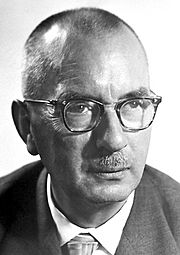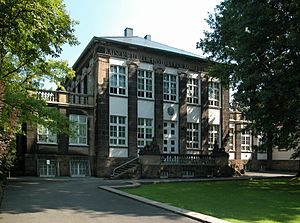Karl Ziegler facts for kids
Quick facts for kids
Karl Ziegler
|
|
|---|---|

Karl Ziegler
|
|
| Born |
Karl Waldemar Ziegler
26 November 1898 Helsa near Kassel, German Empire
|
| Died | 12 August 1973 (aged 74) |
| Nationality | German |
| Alma mater | University of Marburg |
| Known for | Ziegler–Natta catalyst Ziegler process Wohl–Ziegler bromination Thorpe–Ziegler reaction Organoaluminium chemistry Organolithium reagent |
| Awards | Liebig Medal (1935) War Merit Cross 2nd Class (1940) Werner von Siemens Ring (1961) Nobel Prize for Chemistry (1963) |
| Scientific career | |
| Fields | Organic chemistry |
| Institutions | Goethe University Frankfurt University of Heidelberg University of Halle-Saale Max Planck Institute für Kohlenforschung |
| Doctoral advisor | Karl von Auwers |
Karl Waldemar Ziegler (born November 26, 1898 – died August 12, 1973) was a famous German chemist. He won the Nobel Prize in Chemistry in 1963. He shared this big award with Giulio Natta. They won it for their amazing work on polymers. Polymers are like long chains of tiny building blocks. Ziegler is also known for creating the Ziegler–Natta catalyst. This special catalyst helps make new types of synthetic materials. He also studied free radicals and organometallic compounds.
Contents
Early Life and School
Karl Ziegler was born in a town called Helsa in Germany. This was on November 26, 1898. He was the second son of Karl Ziegler, who was a minister. From a young age, Karl loved science. He read many science books even outside of school.
He went to the University of Marburg. He knew so much already that he skipped his first two semesters! His studies stopped for a bit in 1918. He had to serve as a soldier in World War I. After the war, he finished his studies. He earned his doctorate degree from the University of Marburg in 1920.
His Career as a Scientist
After university, Ziegler taught for a short time. He lectured at the University of Marburg and the University of Frankfurt.
In 1926, he became a professor at the University of Heidelberg. He spent the next ten years there. He did a lot of research in organic chemistry. In 1933, he wrote his first big paper. It was about large ring systems in chemistry.
In 1936, he became a professor and director. This was at the Chemical Institute in Halle-Saale. He also taught as a guest lecturer at the University of Chicago. In 1940, he received the War Merit Cross. This was an award given during wartime.
From 1943 to 1969, Ziegler led the Max Planck Institute for Coal Research. This institute was very important for chemical studies.
Karl Ziegler helped rebuild chemical research in Germany after the war. He helped start the German Chemical Society in 1949. He was its president for five years. He also led the German Society for Petroleum Science and Coal Chemistry. In 1971, he became a Foreign Member of The Royal Society in London. This is a very high honor for scientists.
Amazing Discoveries in Chemistry
Ziegler's research covered many areas of chemistry. When he was a young professor, he asked a big question. He wanted to know what made carbon-carbon bonds break apart. This question led him to study many things. He looked at free radicals, organometallics, and ring compounds. Finally, his work led him to polymerization processes.
Making Polyethylene
Since Ziegler worked at the Max Planck Institute for Coal Research, he had a lot of ethylene. Ethylene is a gas that comes from coal. Because it was cheap, Ziegler started working with it. His goal was to make polyethylene that was very strong.
At first, his experiments didn't go as planned. He kept getting a different product, 1-butene. He figured out that tiny bits of nickel salts were causing this. Ziegler realized this was a big clue! If nickel could change the reaction, maybe other metals could help.
Ziegler and his student H. Breil found something amazing. Salts of chromium, zirconium, and especially titanium worked wonders. They made the "growth" reaction happen much faster. They could make high molecular weight polyethylene easily. This was done at low pressures of ethylene. This discovery changed how plastics are made.
His Family Life
In 1922, Karl Ziegler married Maria Kurtz. They had two children, Erhart and Marianna. His daughter, Marianna, became a doctor. His son, Erhart, became a physicist and patent lawyer.
A Love for Art
Karl and Maria Ziegler loved art. They especially enjoyed paintings. They would give each other paintings as gifts. They collected many different types of art. Maria loved flower paintings because she was a gardener. Karl liked paintings of places they lived. Many paintings from their collection are now in the Mülheim Ziegler Art Museum.
His Passing
Karl Ziegler died in Mülheim, Germany, on August 12, 1973. His wife, Maria, passed away in 1980.
Interesting Facts About Karl Ziegler
- Some say a physics textbook first made Ziegler interested in science. He started doing experiments at home!
- Ziegler loved to travel the world with his family. He even planned special trips to watch solar eclipses.
- He made many discoveries and got many patents for them. Because of this, he became a wealthy man.
- With some of his money, he started the Ziegler Fund. This fund helps support research at the Max Planck Institute.
- A high school in Mülheim, Germany, is named after him: the Karl-Ziegler-Schule.
- He received the Liebig Memorial Medal in 1935. This was for his work on ring compounds and free-radical chemistry.
- Karl Ziegler had ten grandchildren.
Awards and Honors
Karl Ziegler received many important awards and honors. Here are some of the most significant ones:
- Liebig-Denkmünze medal (1935): This award is for outstanding achievements in chemistry.
- War Merit Cross, 2nd class (1940)
- Carl Duisberg Plakette (1953): For great service to chemistry.
- Lavoisier Medal (1955): Given by the French Chemical Society.
- Carl Engler Medal (1958): From the German Society of Petroleum Science and Coal Chemicals.
- Werner von Siemens Ring (1960): This is a very high German award for new technology.
- Nobel Prize in Chemistry (1963): For his work on organometallic compounds and new ways to make polymers.
- Swinburne Medal (1964): For major progress in plastics science.
- Grand Merit Cross with Star and Sash (1964): A high honor from Germany.
- International Synthetic Rubber Medal (1967)
- Grand Federal Cross of Merit (1969): For his work in science and technology.
- Pour le Mérite for Arts and Sciences (1969)
- Foreign Member of the Royal Society (1971)
- Wilhelm Exner Medal (1971)
- A memorial tablet was placed at the Max Planck Institute for Coal Research in 2008.
- He received honorary doctorates from several universities.
- The Karl Ziegler Foundation gives out the Karl Ziegler Prize.
See also
 In Spanish: Karl Ziegler para niños
In Spanish: Karl Ziegler para niños
- Dienone–phenol rearrangement
- List of Nobel laureates in Chemistry


